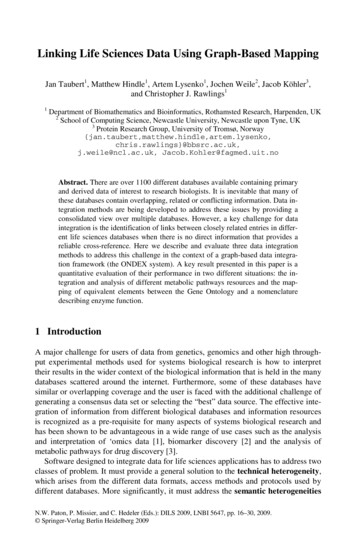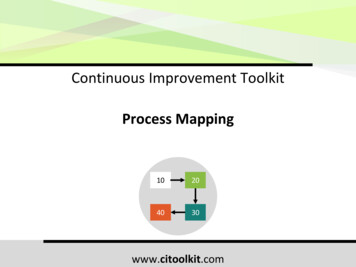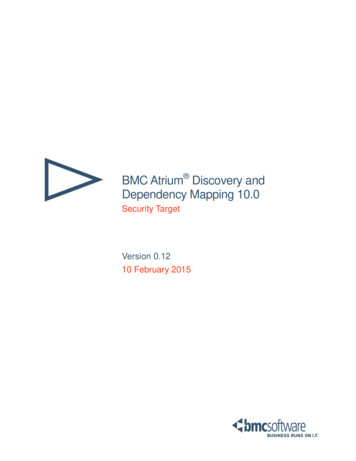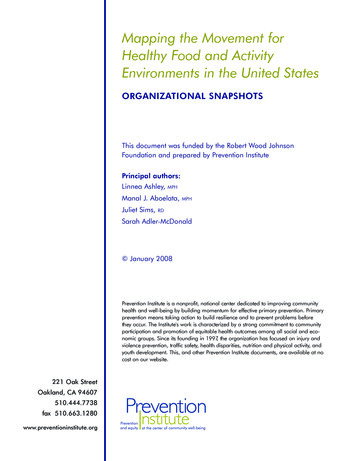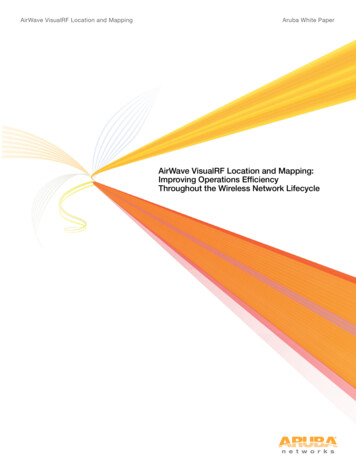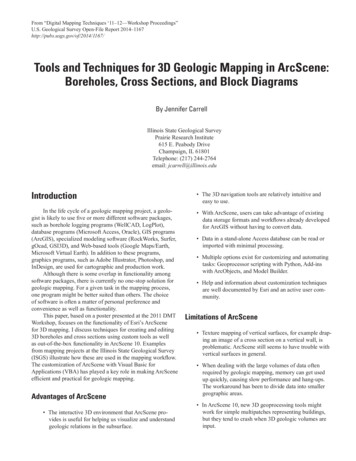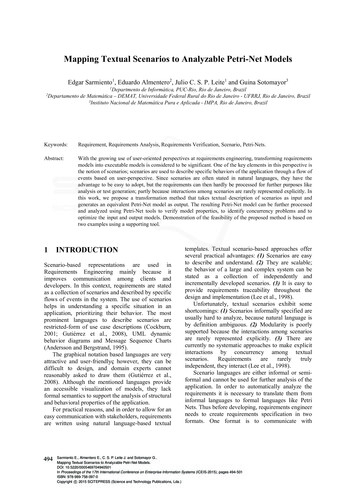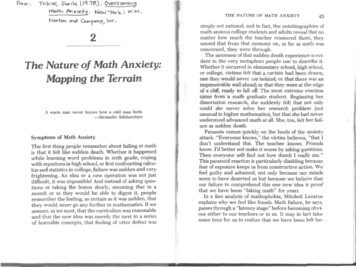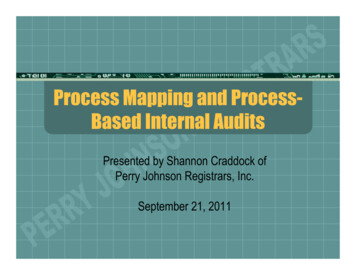
Transcription
Process Mapping and ProcessBased Internal AuditsPresented by Shannon Craddock ofPerry Johnson Registrars, Inc.September 21, 2011
Today’s Topics WhyAre We Doing This? Process Terminology Process Mapping Symbols Different Ways to Visualize a Process Bakeries: A Practical Example Process Approach to Auditing
Why Are We Doing This? Outcomesshould matter to certified organizations and tobodies, such as PJR, offering accredited certification. Someorganizations get certified because of customermandates or to “fly the flag.” There is a push for certification bodies to not just look forconformity to requirements but for clear measures of trueprocess improvement. After all, shouldn’t organizations derive benefit from accreditedcertification?
Outcomes Matter Anaccredited QMS certification process mustensure the following: Anorganization’s QMS must meet the requirementsof the relevant standard. The QMS analyzes and understands customerrequirements and is aware of relevant statutory andregulatory requirements. Product characteristics have been defined.
Outcomes Matter Anaccredited QMS certification process must ensure thefollowing: TheQMS has identified and manages the processesneeded to achieve the expected outcomes. The QMS aims to prevent nonconformities and has processesin place to correct nonconformities, analyze root cause andtake corrective action. (Focus of PJR’s Root Cause andSystemic Corrective Action Seminars). The organization is monitoring, measuring andcontinually improving the effectiveness of its QMS.
Outcomes Matter Anaccredited EMS certification process mustensure the following: Theorganization is managing its environmentalimpacts. The organization is demonstrating commitment topreventing pollution, meeting legal requirements andcontinually improving environmentalperformance.
Outcomes Matter Today’sseminar focuses on helping your organizationaccomplish the following: TheQMS has identified and manages the processesneeded to achieve the expected outcomes. The organization is monitoring, measuring andcontinually improving the effectiveness of its QMS. The organization is continually improving itsenvironmental performance.
The BasicsProcess Mapping Terminology
Terminology Process– a sequence of steps, activities,decisions or tasks that transforms inputs intooutputs. Wetalk about “adding value.” This is when theoutputs of a process are of greater value than theinputs.InputsCustomer who has aneedProcess“Add Value?”OutputsCustomer who hasa need met
Terminology ProcessBoundaries – designated start and endpoints of a process. Shouldbe logical Must be determined before a process can bedescribed. Usually defined as a “customer with a need” and a“need being met.”
Terminology ProcessInputs – any product or service used in theprocess People Equipment Material Documentation Environment Suppliers Internal– provide the needed inputs for a processSuppliers External Suppliers
Terminology Outputs– a product or service created by the processthat is of value to the customer. Evidencethat work has been completed. Must be specific Output of one process is often the input of another. Customers– individuals who benefit from the products orservices produced by the process Internalcustomers External customers
Terminology Customer requirements– needs, wants orexpectations that internal or external customershave for the output of the process Maybe written or unwritten Processowners – an individual(s) who is/areaccountable for the process. Determinedby the process boundaries May be a team of people
Terminology ProcessApproach – the application of a systemof processes within an organization, together withthe identification and interactions of theseprocesses, and their management. Processesshould be automatic and instinctive toall personnel.
The BasicsProcess Mapping Symbols
Process Mapping Symbols Rectangles– used to identify a discrete activity inthe process. Content of rectangle is usually averb and direct object. Lines with Arrowheads – Represent the directionand flow of the activities in a process.Visually inspectpartsPlace greenlabel onconforming partsPack parts
Process Mapping Symbols Startand end ovals – used to signify the startingpoint and end point of a process, the“boundaries.”StartEnd
Process Mapping Symbols Decision Diamonds – represent a decision ina process, a question that must be answeredwith a yes or no. Haveone line entering and two lines leaving (yesand no) Is the part YES Pack in plasticconforming?NOLabel with red tag andplace innonconforming binbin
Process Mapping Symbols Loop– displays a part of the process that repeatsitself until a specific condition is met. Oftentakes the process back to other steps. Indicate areas where activities such as rework areneeded.Inspect part andremove excessflashIs partfree fromflash?NOYESPlace green labelon part andpack in plastic bin
Process Mapping Symbols Circles– used to reference or connect anotherpart of the process when the process continuesto another page.B
Process Mapping Symbols Parallelprocess – process or process steps thatoccur at the same time as another process.
The BasicsDifferent Ways to Visualize a Process
Benefits of Making a ProcessVisible ProcessImprovement Allowsrelationships and sequences to be identified andanalyzed Serves as an aid to problem solving Educationand Training Wayto train employees on changed processes Assist in training new employees Documentation Clarifiesthe flow of work in a process Eliminates the need for lengthy procedures and workinstructions in narrative format
Flow of Work in a Single Process BlockDiagrams Process Maps VISIO Microsoft
Block Diagram Simple Usesschematic of the major steps of a processrectangles or “blocks” and arrows Answers the question: “What is the process?”
Process Map Detailed schematic of the steps, activitiesor tasksthat shows how something is done Showsdecision points and feedback loops Answers the question: “What is the process and howdoes it work?”
Sequence and Interaction ofProcesses Showsthe interrelationship of all of anorganization’s processes Thisis different that block diagrams and processmaps of single processes. Don’t forget outsourced processes! Requirement of ISO 9001:200814001:2004and ISO
Sequence and Interaction ofProcesses Relevant ISO “The9001:2008 clausesorganization shall identify the processesneeded for the quality management system andtheir application throughout the organization,[4.1a] determine the sequence and interaction of theseprocesses, [4.1b]
Sequence and Interaction ofProcesses Relevant ISO “The9001:2008 clausesorganization shall establish and maintain aquality manual that includes a description of theinteraction between the processes of the qualitymanagement system.” [4.2.2c]
Sequence and Interaction ofProcesses Relevant ISO “The14001:2004 clauseenvironmental management systemdocumentation shall include a description of the mainelements of the environmental management systemand their interaction ” [4.4.4c]
Wake Up!This is the Most Important Slide Beforewe can talk about a sequence and interaction ofall processes of an organization, we must first: Determine Thisthe processes of an organization (STEP 1)is a critical but often not performed step. Many organizations simply construct a block diagram or process mapof their main (manufacturing) process – This is not sufficient anddoes not meet the intent of ISO 9001:2008. Required by clause 4.1a of ISO 9001:2008 and clause 4.4.4c of ISO14001:2004.
Stay Up!This Slide is Just as Important Bring staff together fromvariousdepartments/functions and brainstorm theprocesses of your organization. (Step 1) For this exercise, put ISO 9001:2008 and ISO14001:2004 away. Better yet – forget they exist! Processesshouldn’t be named after headings or subheadings of the standard. Processes should be unique to your organization andmatch the language your employees speak.
Stay Awake! Onceyou determine the processes of your organization,focus on each process individually (Step 2): Determinethe boundaries of each individual process Generate a list of steps of the process Shouldbe broken down until further breakdown no longer contributesadditional value. Write each step on an index card or sticky note Sequence Easythe stepsto move index cards or sticky notes Required by clause 4.1b of ISO 9001:2008
Remember the Theme Rememberthe theme of today’s presentation OutputsMatter! Theorganization is monitoring, measuring andcontinually improving the effectiveness of its QMS. Foreach process, the organization must identify ameasure of process performance and an associatedtarget. (Part of Step 2) Keyperformance indicator (KPI) Required by clause 4.1e of ISO 9001:2008 and clause 4.3.3 ofISO 14001:2004.
Remember the Theme Inappropriate Improvemeasures of processescustomer satisfaction Strive to continually improve all processes Improve delivery performance Reduce employee turnover Lower PPM
Remember the Theme Thereshould be a measure of process effectiveness foreach identified process of the organization. Some appropriate examples include: Maintaina close ratio of at least 30% for all quotations Scrap rate of 2% Manufacturing process efficiency of 95% Receive corrective action plans for all internal auditnonconformities within 30 days Completion of all planned internal audits Measurablesmay be “variable” or “attribute” in nature.
Remember the Theme Whathappens when a target isn’t met? Correctiveaction is required per clause 8.2.3 of ISO9001:2008: “Theorganization shall apply suitable methods for monitoring and,where applicable, measurement of the quality management systemprocesses. When planned results are not achieved, correction andcorrective action shall be taken, as appropriate, to ensure conformityof the product.” Consideralso clause 8.4c of ISO 9001:2008: “Theorganization shall determine, collect and analyze appropriatedata to demonstrate the suitability and effectiveness of the qualitymanagement system The analysis of data shall provide informationrelating to characteristics and trends of processes and productsincluding opportunities for preventive action ” Arewe trending in the right direction?
Stay Awake! Earlierwe learned that the output of one processis the input of another. Watchfor these linkages as you construct processmaps for individual processes. Theselinkages will help you determine thesequence and interaction of all processes of yourorganization (Step 3).
BakeriesA Practical Example
Bakeries – Block Diagram for aSingle Process Followingis an example of a block diagram or processmap for a bakery specializing in wedding cakes. Input:Receive specification sheet and order for a weddingcake. Output: Wedding cake ready for delivery. Appropriatemeasures of effectiveness (KPI) for theprocess of baking and decorating a wedding cake arealso included. Repeat this exercise for all processes in yourorganization.
Bakeries – Sequence andInteraction of Process Following isan example of a sequence andinteraction of processes for an entireorganization, our bakery. Note this is different than a block diagram orprocess map of a single process.
Process Approach to Auditing
Process Approach to Auditing Different than Checklistsa checklist auditturn the requirements of the standard intoquestions. Checklist questions never change or grow with theprocess. Internalaudits should be one driver of processimprovement Aprocess approach to internal audits does just that.
Process Approach to Auditing Needto get away from the idea that an internalaudit should confirm your management systemaddresses all the shalls or requirements of astandard. Importanceof a tool such as PJR Form F-191 orequivalent documents
Process Approach to Auditing Once you know your management systemprocesses address all the requirements of thestandard, then you can audit processes as yourorganization has defined them. Keepin mind the requirements of section 4.1 of ISO9001:2008 as you audit the processes of yourorganization.
ISO 9001:2008, section 4.1 “Theorganization shall identify the processes needed for the qualitymanagement system and their application throughout the organization,[4.1a] determine the sequence and interaction of these processes, [4.1b] determine criteria and methods needed to ensure that both theoperation and control of these processes are effective, [4.1c] ensure the availability of resources and information necessary tosupport the operation and monitoring of these processes, [4.1d] monitor, measure and analyze these processes, and [4.1e] implement actions necessary to achieve planned results and continualimprovement of these processes.” [4.1f]
Process Approach to Auditing Developmentof an audit working document that focuseson: Processinputs Process outputs Competencies required for the process Requirements for the process (procedures, work instructions,customer drawings) Equipment and other resources Measures of process effectiveness
Process Approach to Auditing Interview theprocess owner using the auditworking document as a tool. Confirm interview results through observation ofthe process, review of process documents andrecords and interviews with personnel actuallyperforming the process.
Process Approach to Auditing Alwaysask: “How do you know the process isworking/improving?” Linkto process measurable (KPI) Remember Outcomes Matter! Alwaysask: “What do you do/how do you reactwhen the process does not meet the definedtarget?”
Other Techniques for EffectiveInternal Audits Rememberthe guidance provided in the RootCause/Systemic Corrective Action Seminar abouthow to properly document an audit finding: Statementof Finding Objective Evidence Citation of requirement not being fulfil
Many organizations simply construct a block diagram or process map of their main (manufacturing) process –This is not sufficient and does not meet the intent of ISO 9001:2008. Required by clause 4.1a of ISO 9001:2008 and clause 4.4.4c of ISO 14001:2004. Stay Up! This Slide is Just as Important Bring staff together from various departments/functions and brainstorm the processes of your .
